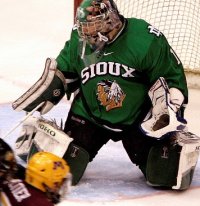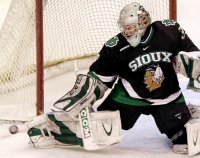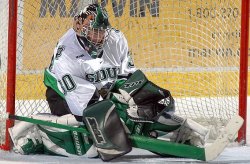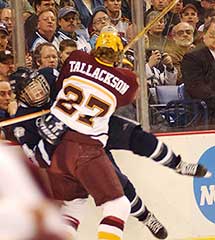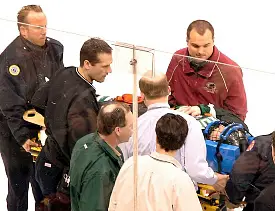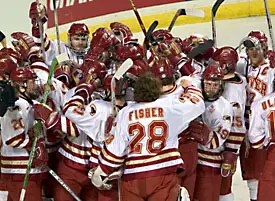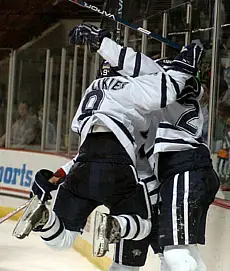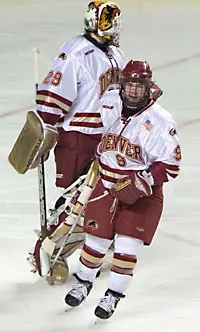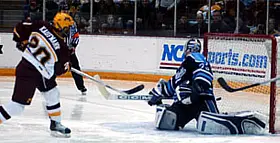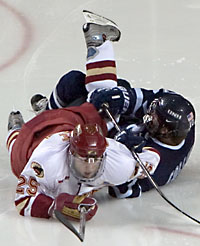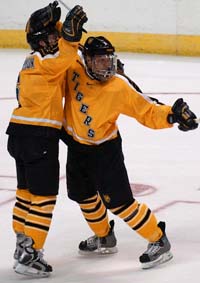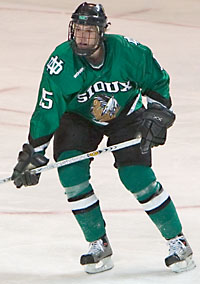Since October, I’ve been crisscrossing the Northeast catching almost every men’s and women’s D-I hockey team that I could, so when the end of the season rolled around, I figured I had to go out in style.
I decided — with some amount of egging on from my colleague Eric Mirlis, I might add — that while at the University of New Hampshire for the Women’s Frozen Four, I would use the off day between the semifinals and finals to go to all three games in [nl]Amherst and Worcester of the men’s regionals.
Saturday morning, I set out from the UNH campus in Durham to see three games: Denver against Bemidji State and UNH against Harvard at the Mullins Center in [nl]Amherst, and Boston College against North Dakota at the DCU Center in Worcester.
9:35 a.m. – I depart from my overnight lodging at the UNH chapter of my fraternity, Sigma Nu. I’m leaving a bit later than I’d expected, thanks in large part to my brothers, who had a spirited session of Karaoke Revolution going on when I arrived at the house and kept me up until about 2:30.
9:36 – I find a parking ticket on my windshield. What a lovely way to start the day.
9:37 – The opening chords of Barenaked Ladies’ “My Celebrity” come through my car’s speakers as I set out for [nl]Amherst. “Don’t call me a zero, I’m going to be a hero, like Phil Esposito or the Kennedys…”
9:56 – I realize that I took a wrong turn, getting on New Hampshire Route 16 going north instead of south.
11:40 – While driving on Massachusetts Route 2, I realize how poorly connected Durham and [nl]Amherst are. I slowly realize that I’m not going to be in my seat by the puck drop.
12:20 – I arrive in [nl]Amherst. Great, just great.
12:30 – I find a parking space. Even better.
12:45 – I make my way to the press entrance, wondering why these arenas always put press entrances so far away from the main entrance to the building.
12:48 – I grab some food and say hi to a few familiar faces: Adam Wodon, Jayson Moy, and selection committee member Wayne Dean, who I’ve gotten to know pretty well on my many trips to Yale this year.
12:55 – On my way to my seat, I run into Harvard coach Ted Donato, and we have a short, but pleasant, conversation. The memorable line comes not from Donato, though, but assistant coach Sean McCann. While discussing last night’s Women’s Frozen Four semifinal win by Harvard, I mention that the Crimson’s Nicole Corriero scored a goal right in front of Hockey Canada scout Wally Kozak, who has recently drawn criticism for saying that Corriero would need to “literally learn to skate” in order to be considered for the Canadian National Team despite her NCAA record 59 goals this season. McCann says, “I wish I ‘couldn’t skate’ like that.” Me too, Sean. Me too.
1:00 – I arrive at my seat to find that it’s been filled in my absence…by none other than CSTV’s Dave Starman, who cites “veteran privilege” in taking the seat. It’s a shame that his “veteran privilege” doesn’t entitle him to some Rogaine, too.
1:01 – The puck drops for the start of the second period, with Denver and Bemidji State tied 2-2. Well, at least I’ll see the game-winner.
1:03 – Denver Kevin Ulanski scores the go-ahead goal for the Pioneers, blasting the puck through the five-hole of BSU goalie Matt Climie.
1:38 – End of the second period, with Denver leading 3-2. This is my first live look at both teams, and I’m enjoying the show
1:42 – A fan wanders up to the press box looking for someone to complain to about the music, which he doesn’t feel is appropriate to the hockey spirit. Given that the current song is Gwen Stefani’s “Rich Girl,” I find it hard to disagree, but also find myself unable to point the man in the right direction.
1:53 – The puck drops for the start of the third period.
1:57 – Bemidji gets the game-tying goal, courtesy of a Brendan Cook redirection. A loud rendition of the Bemidj fight song follows.
2:02 – Denver’s Jussi Halme crashes into the net, which could not have been fun for Beavers’ goalie Matt Climie.
2;04 – Bemidji’s David Deterding takes a penalty for holding the stick. Starman says, “This could be a ball-breaker right here.”
2:05 – A chant of “Let’s Go Beavers” breaks out in the arena, and it’s not just the Bemidji section. Just like in basketball, everyone loves the plucky underdogs.
2:18 – Denver ices during a power-play after the Beavers clear the puck, and a mighty roar rises from the crowd. I wonder how many people in the building actually know exactly where Bemidji is.
2:27 – With 1:18 left on the clock and the score still tied, I realize the likelihood of this game going to overtime. Given that I don’t have a whole lot of wiggle-room for trying to get to Worcester after the second game, I’m hoping to avoid overtime. A late goal would serve me quite nicely.
2:30 – Overtime it is. While I respect the effort the Beavers have put in to this point, I find myself slightly annoyed at them for two reasons: 1) my upcoming drive to Worcester; and 2) I have Denver winning it all in my bracket pool.
2:45 – The puck drops for overtime.
2:51 – It’s over. Kevin Ulanski redirects a Brett Skinner shot past Climie for the game-winner. The Beavers get a standing ovation, but midnight has come for the would-be Cinderella
2:52 – Is it over? The teams are still shaking hands as the goal is announced as being under review.
2:53 – Yes, it’s over. The goal is good, and both my bracket and my trip to Worcester are momentarily saved.
3:45 – Puck drops on the second game, Harvard and New Hampshire. I actually get my seat for this one, as Mr. Starman has so graciously allowed me to have it.
3:56 – I look down at the nametag on my seat, and find that my name has been misspelled: “Eliot Olshansky.” This isn’t the first time, and I’m pretty sure it won’t be the last.
3:58 – Ryan Maki scores during a 4-on-4 to make it 1-0 Crimson, and a recording of “10,000 Men Of Harvard” is played over the PA.
4:03 – Harvard’s Ryan Lannon takes a penalty for interference, prompting the UNH fans and band to direct Mr. Lannon to the penalty box: “Skate, skate, skate, skate…SIT DOWN!!”
4:17 – End of the period, Harvard still leads 1-0.
4:32 – Puck drops on period two.
4:35 – Steve Mandes takes a penalty for the Crimson. “Skate, skate, skate…”
4:39 – I start to realize what CSTV’s Mike Eruzione was talking about when he said that Sean Collins is the kid who makes New Hampshire go.
4:40 – During a TV timeout, we’re treated to Cake’s “The Distance.” Not only is that more like it in terms of hockey-appropriate music, but I haven’t heard that song in at least a year, and it’s a favorite.
4:43 – “Skate, skate, skate…” escorts Crimson captain Noah Welch to the box.
4:44 – Sean Collins escorts him out with a power-play goal.
4:45 – Just like that, Harvard’s back on top. Alex Meintel scores his first career goal, making Crimson defenseman Dave MacDonald the only skater dressed for the Crimson without a goal this season.
4:50 – I fear for the safety of the UNH pep band conductor, who is standing on the plastic armests of a Mullins Center seat as he conducts the Wildcat musicians in “Eye of the Tiger.”
4:52 – Peter Hafner “Skates, skates, skates” to the box.
4:54 – The pep band conductor has opted for a safer route, conducting “Hold On, I’m Coming” from the seat of a folding chair.
4:55 – A graphic on the scoreboard congratulates Wake Forest on its 2004 NCAA Field Hockey championship. I wonder if I’m the only one in the building who realizes that the Demon Deacons steamrolled the Crimson in the first round of that tournament.
4:57 – Another TV timeout gives the Wildcat band a chance to show what it can do, pulling off a very well arranged version of Dexy’s Midnight Runners’ “Come On Eileen.”
5:03 – Time for Charlie Johnson to “Skate, skate skate…” If you’re wondering why I don’t take note of the UNH penalties, it’s because none of the Harvard fans actually say anything on those penalties.
5:04 – Mandes gets to “Skate, skate, skate,” giving the Wildcats a 5-on-3 for 1:08. Welch, Hafner and Tom Cavanaugh are the killers.
5:07 – Back to full strength after a great penalty kill by the Crimson, and I wonder if Dov Grumet-Morris is ever going to give another one up.
5:12 – End of the second, and it’s 2-1 Crimson.
5:15 – As I make my way back down to the press room, I’m impressed by the number of jerseys I see from teams that aren’t at the Mullins Center. Maine, Michigan State, Cornell.
5:19 – We get word that the Minnesota-Maine game has ended, with the Golden Gophers coming out on top. For the record, I picked Maine in my bracket.
5:21 – I run into Dave Starman again in the press room, and Harvard’s Joe Heidelberg shows us a replay of the Meintel goal on his computer. As much as it was annoying to have Dave in my seat for the first game, he’s certainly good to be around in the press room, because it seems like just about everyone knows the guy.
5:25 – Dave and I run into Adam Wodon, and for everyone who wonders if the banter between those two is the same off the air as it is on, I will tell you: it is. It felt like I was in the middle of our studio show. Adam, apparently, already has the hate mail pouring in for picking Maine to beat Minnesota. Please. I defy any Gopher fan to tell me that he or she had supreme confidence in the ‘U’ after two loses at the WCHA Final Five and a rough second half of the regular season. And against a top goalie like Jimmy Howard, no less. As I said, I had the Black Bears, too. Bug me, the rookie, not someone who does as much to promote the game as Adam. OK, I’m getting down off of my soapbox now, but I’ll accept all Gopher fan hate mail at [email protected].
5:26 – Before heading back to the press box Michigan-CC. Dave goes nuts as we think it’s 6-2, until we realize that’s SOG.
5:27 – The puck drops on the third period.
5:28 – Dylan Reese “Skate Skate Skates” off the ice.
5:29 – Preston Callander ties it up for UNH.
5:57 – Last TV timeout. Someone score. I don’t care who. I don’t care if it kills my bracket; just let this end on time so I can get to Worcester.
5:58 – UNH hits the post. Yep, we’re going to go to overtime.
6:02 – Overtime…gotta love it.
6:17 – Puck drops on OT. Please, let’s get this over quick.
6:24 – Wildcat Josh Ciocco is laid out behind the Harvard goal. He gets up and skates off under his own power, and will return later in the period.
6:26 – The UNH band treats us to a rendition of Twisted Sister’s “We’re Not Gonna Take It.” As someone who as actually seen Dee Snider and company perform live, I appreciate the choice.
6:39 – The official in the Harvard penalty box has a scary moment, as a puck flies into the sin bin and nearly takes his head off. He’s OK, and gets a standing ovation from the crowd for his toughness.
6:40 – It’s over, thanks to a Daniel Winnik redirection. Time for a quick press conference, then on to Worcester. This should be fun.
6:50 – Harvard press conference with Donato, goalie Dov Grumet-Morris and captain Noah Welch. I stand and watch as the two seniors discuss the last game of their college careers. I don’t think that college athletes and coaches ever get quite enough credit for how they deal with the media, especially after losses. Sometimes, I find myself sitting in a press conference or on a phone call, asking a current or former player to relive an emotionally painful moment, and I wonder who the hell I think I am. So far as I can tell, though, none of the athletes I’ve worked with have had the same question about me, and that really speaks a lot to the character and maturity of the people I’m so fortunate to work with.
7:00 – New Hampshire press conference. Obviously, much less emotional pain for these guys, but I have to tip my hat to Sean Collins, who, in talking about motivation heading into overtime, mentions how good the food was at the restaurant the Wildcats ate at Friday night, and how everyone wanted to go back. I’ll tell you what: if hockey doesn’t work out for Sean — but I believe it will — the man definitely has a future in comedy.
7:15 – I get back in the car, pop in Red Hot Chili Peppers’ “By The Way,” and start driving.
7:23 – Not quite sure of where I’m going, I ask for directions at Bruno’s Pizza and Subs. One of the delivery folks sets me straight, and I head back toward Worcester.
7:30 – I get stuck in traffic on Massachusetts Route 9. Decorum prevents putting my thoughts down on paper…or the Internet, for that matter.;
7:50 – As I get onto the Massachusetts Turnpike, I silently hope that I don’t miss any more than the first period.
8:45 – I pay $20 and pull into a parking garage. That’s one of the nice things about campus sites…parking is much more reasonable, if you have to pay at all. Oh well, note to self: make sure you submit your expenses this month.
9:00 – The puck drops on the second period.
9:06 – 5-on-3 power-play for the Eagles, as I realize that both teams have a player named Matt Greene (the one from the Sioux is in the box).
9:08 – Play has yet to resume, as referee Matt Shegos is still getting a cheerful earful from Sioux coach Dave Hakstol.
9:09 – Back to action, and the Eagles can’t do much with the two-man advantage.
9:10 – Joe Rooney brings the 5-on-3 to an end by taking a slashing penalty.
9:12 – Ryan Murphy collides with Sioux goalie Jordan Parise, earning his own trip to the penalty box in the process. It looks bad for Jordan, but he shakes it off and keeps going.
9:14 – All of a sudden it’s a Sioux 5-on-3.
9:25 – The scoreboard shows J.P. Parise as he watches his son in action. There’s a proud papa.
9:27 – Travis Zajac makes it 4-0 in favor of the Sioux.
9:30 – B.C. finally gets something on the scoreboard, thanks to Chris Collins. It took the Eagles 32:29 to solve Parise, which is a problem I’ve noticed for B.C. all season long (this is my sixth time seeing them in person this year).
9:32 – The Sioux onslaught continues, as an off-angle shot is fired by [nl]Colby Genoway that somehow finds its way into the net.
9:34 – Goal under review, because no one quite understands that “somehow.”
9:37 – No goal. Apparently, Cory Schneider’s skate lifted the net up just enough for the puck to slide under, which makes sense, since the angle of the shot seemed very off to me when I saw Genoway take the shot.
9:39 – Play resumes.
9:44 – Another 5-on-3 for the Sioux, with Mike Brennan and Joe Rooney in the box. The Eagles kill it off.
9:52 – Some extracurricular activity breaks out with 26.7 seconds to go and both Zajac and BC’s Dan Bertram wind up in the box.
9:54 – End of the second period with North Dakota on top 4-1. I should note that at this point, I have seen 30 of the 58 Division I teams play live this season: All nine Hockey East teams; the entire ECACHL except for Vermont, St. Lawrence and Union; all of Atlantic Hockey except for Canisius and Sacred Heart; Robert Morris, Air Force, Bemidji State, Denver, and the Sioux.
10:08 – As the refs take the ice for the third period, the BC band serenades them with a wonderful rendition of “Three Blind Mice.”
10:10 – Puck drops on the third period, as we’re still skating 4-on-4 from the Bertram-Zajac scuffle in the second.
10:15 – Brennan goes to the penalty box for holding the stick, a very unpopular call, as Brennan took a pretty nasty fall
10: 16 – Shorthanded goal for Dave Spina, who takes a long pass from Ryan Shannon at the blue line, skates in, goes to his backhand and roofs it into the net.
10:20 – We have another TV timeout, and the BC band treats us to “Carry On Wayward Son.” At Conte Forum, the Eagle band has its own entrance, and they sound good enough that I think they deserve it. Although, personally, I think more pep bands should have their own entrances to the building. They certainly bring a lot to the game. And yes, I did play in a pep band in college, so make of my motives what you will.
10:22 – Chris Porter brings the North Dakota lead back to three, as he takes a gorgeous pass from Andy Schneider, brings it in from the blue line, and puts it past Cory Schneider on his stick side. A large cheer goes up from the Sioux fans, one of whom waves a bright green “UND” flag, oblivious to the fact that it’s upside down.
10:32 – Brian Canady and Mike Prpich come in on a 2-on-1, and Canady takes the shot himself, puts it away, sending fans for the exits with 8:52 on the game clock.
10:33 – With the BC band playing “(Our) School’s Out,” Matti Kaltiainen is sent in to finish the game. The senior will get to finish his career on the ice rather than the bench. Unfortunately for him and his team, it’s mop-up duty.
10:41 – There are a total of five players in the penalty box, the most recent entries being Andy Schneider and BC’s Brian Boyle, who got into it after the whistle. I start to wonder if they’re putting something in the water bottles.
10:43 – Chris Collins gets another goal for the Eagles, and with 4:36 to play, a faint glimmer of hope remains for the local favorites.
10:45 – “Where’s the Puck?” In Parise’s right pad.
10:50 – There’s 1:56 left on the clock, and these teams are still very, VERY chippy. This time, it’s Prpich and Ryan Murphy getting tangled up. It’s almost as though the teams don’t like each other. Oh, wait…
10:54 – Game over, and North Dakota is going to Columbus. I meanwhile, am going down to the interview room.
11:40 – Press conferences are over, and it’s time to write.
11:54 – I finish my business, grab four Diet Cokes from the hospitality room and head for my car.
12:00 a.m. – I set out for Durham to the sounds of Five For Fighting. Yes, I am that much of a hockey geek, as the band named for a penalty has accompanied my drive home after the last game of every single road trip I’ve taken this season.
1:40 a.m. – I return to the frat house, definitely ready for sleep. Goodnight, everybody!
